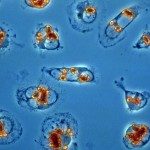Lien vers Pubmed [PMID] – 10760143
Mol Microbiol 2000 Mar; 35(6): 1421-30
Saccharomyces cerevisiae PAU genes constitute the largest multigene family in yeast, with 23 members located mainly in subtelomeric regions. The role and regulation of these genes were previously unknown. We detected PAU gene expression during alcoholic fermentation. An analysis of PAU gene regulation using PAU-lacZ fusions and Northern analyses revealed that they were regulated by anaerobiosis. PAU genes display, however, different abilities to be induced by anaerobiosis and this appears to be related to their chromosomal localization; two subtelomeric copies are more weakly inducible than an interstitial one. We show that PAU genes are negatively regulated by oxygen and repressed by haem. Examination of PAU gene expression in rox1Delta and tup1Delta strains indicates that PAU repression by oxygen is mediated by an unknown, haem-dependent pathway, which does not involve the Rox1p anaerobic repressor but requires Tup1p. Given the size of the gene family, PAU genes could be expected to be important during yeast life and some of them probably help the yeast to cope with anaerobiosis.


